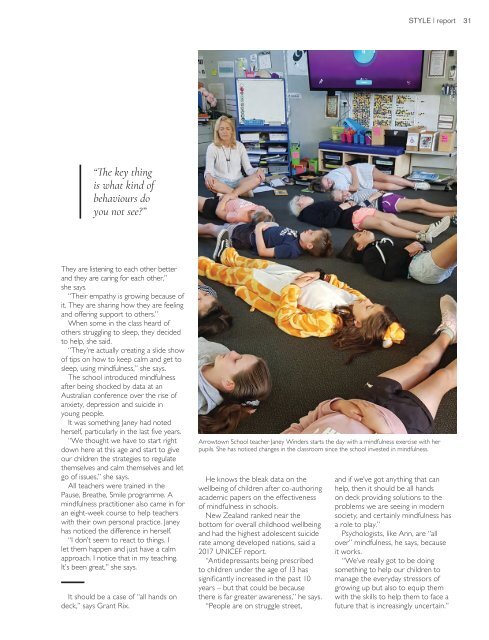Style: January 08, 2020
You also want an ePaper? Increase the reach of your titles
YUMPU automatically turns print PDFs into web optimized ePapers that Google loves.
STYLE | report 31<br />
“The key thing<br />
is what kind of<br />
behaviours do<br />
you not see?”<br />
They are listening to each other better<br />
and they are caring for each other,”<br />
she says.<br />
“Their empathy is growing because of<br />
it. They are sharing how they are feeling<br />
and offering support to others.”<br />
When some in the class heard of<br />
others struggling to sleep, they decided<br />
to help, she said.<br />
“They’re actually creating a slide show<br />
of tips on how to keep calm and get to<br />
sleep, using mindfulness,” she says.<br />
The school introduced mindfulness<br />
after being shocked by data at an<br />
Australian conference over the rise of<br />
anxiety, depression and suicide in<br />
young people.<br />
It was something Janey had noted<br />
herself, particularly in the last five years.<br />
“We thought we have to start right<br />
down here at this age and start to give<br />
our children the strategies to regulate<br />
themselves and calm themselves and let<br />
go of issues,” she says.<br />
All teachers were trained in the<br />
Pause, Breathe, Smile programme. A<br />
mindfulness practitioner also came in for<br />
an eight-week course to help teachers<br />
with their own personal practice. Janey<br />
has noticed the difference in herself.<br />
“I don’t seem to react to things. I<br />
let them happen and just have a calm<br />
approach. I notice that in my teaching.<br />
It’s been great,” she says.<br />
It should be a case of “all hands on<br />
deck,” says Grant Rix.<br />
Arrowtown School teacher Janey Winders starts the day with a mindfulness exercise with her<br />
pupils. She has noticed changes in the classroom since the school invested in mindfulness.<br />
He knows the bleak data on the<br />
wellbeing of children after co-authoring<br />
academic papers on the effectiveness<br />
of mindfulness in schools.<br />
New Zealand ranked near the<br />
bottom for overall childhood wellbeing<br />
and had the highest adolescent suicide<br />
rate among developed nations, said a<br />
2017 UNICEF report.<br />
“Antidepressants being prescribed<br />
to children under the age of 13 has<br />
significantly increased in the past 10<br />
years – but that could be because<br />
there is far greater awareness,” he says.<br />
“People are on struggle street,<br />
and if we’ve got anything that can<br />
help, then it should be all hands<br />
on deck providing solutions to the<br />
problems we are seeing in modern<br />
society, and certainly mindfulness has<br />
a role to play.”<br />
Psychologists, like Ann, are “all<br />
over” mindfulness, he says, because<br />
it works.<br />
“We’ve really got to be doing<br />
something to help our children to<br />
manage the everyday stressors of<br />
growing up but also to equip them<br />
with the skills to help them to face a<br />
future that is increasingly uncertain.”


















